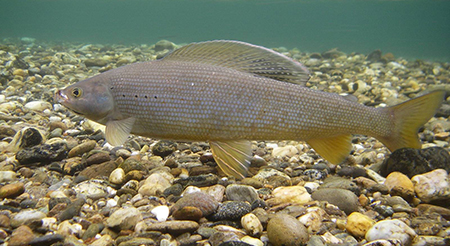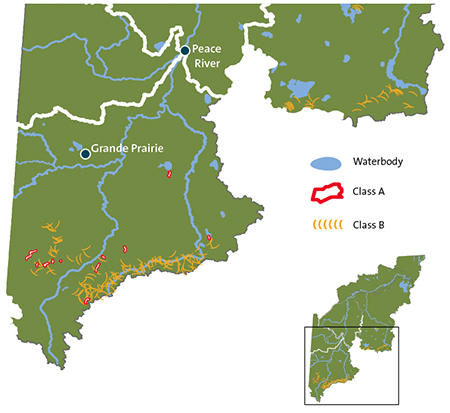| |
Habitat
The majority of flowing and standing water is fish habitat. The Alberta Government Codes of Practice criteria capture and classify these waters as important to fish habitat. The Codes of Practice provide rankings from A to D, based on fish populations or species and life stage use of the habitats within each area. A classification of "A" suggests unique and limiting habitat and prescribes restrictions on many activities, while "D" acknowledges that habitat is present but restrictions are not necessary. In specific cases, some flowing waters with recognized water allocation pressures may determine minimum flows to protect fish populations.15
The map above shows the distribution of class A and B fish habitat areas, as mapping all fish habitat is impractical at this scale.
Source
Locke, A. and A. Paul. 2011. A desk-top method for establishing environmental flows in Alberta
rivers and streams. Alberta Environment and Alberta Sustainable Resource Development.
Edmonton, AB
Estimated Densities of Adult Walleye
| Sub-Basin |
Lake |
Density |
Uncertainty |
| Smoky/Wapiti |
Snipe
Iosegun
Smoke, Sturgeon |
Low
Moderate
High |
Low
Low
Low |
| Wabasca |
Loon, Vandersteen
Wadlin
Gods, South Wabasca
Utikuma
Peerless
Graham
North Wabasca, Round
Utikumasis |
Low
Low
Low
Low
Moderate
Moderate
Moderate
Moderate |
High
Moderate
Low
Low
High
Low
Low
Low |
| Central Peace |
Sawn
Haig |
Low
High |
Low
Low
|
| Lower Peace |
Wentzel
Caribou |
Low
Moderate |
High
High |
|
| 
Adult Fish Density in Streams and Rivers

Source: ESRD Code
of Practice for
Watercourse
Crossings |
|